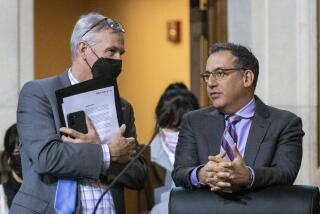L.A. budget official seeks new cuts in spending, delay in police hiring
Los Angeles budget officials called Friday for a vast array of spending cuts that, unless city workers step forward with a new round of concessions, would still fall short of closing a projected $404-million gap.
Looking to get through the next 15 months, City Administrative Officer Miguel Santana called for reductions of 20% or more in funding for graffiti removal, senior centers, school crossing guards, neighborhood councils, cultural programs and the 311 system that fields calls from the public.
Santana also said no new police should be hired until July at the earliest, a move that would cause the Los Angeles Police Department to fall up to 68 officers below the staffing level sought by Mayor Antonio Villaraigosa. That idea was swiftly denounced by Villaraigosa Deputy Chief of Staff Matt Szabo, who said it “makes no financial or operational sense.”
“The only way this plan saves any money at all is through a permanent reduction to the police force, which the mayor is not willing to entertain,” Szabo said.
In a 440-page report, Santana warned that the construction of one animal shelter in South Los Angeles would probably require the closure of another nearby. He called for the Department of Disability to be folded into another agency. And he said the Board of Public Works — a five-member panel of mayoral appointees who make $123,000 annually — should be replaced with part-time volunteers.
Unless the Coalition of L.A. City Unions agrees to reduce salaries or benefits, its members will probably need to take 36 furlough days next fiscal year, Santana wrote. Beyond that, Santana advised Villaraigosa and the council to press ahead with a series of long-term financial fixes, such as finding private groups to run such facilities as the Los Angeles Convention Center, the Los Angeles Zoo and an animal shelter in the San Fernando Valley.
Villaraigosa will propose his budget next month, one that may or may not include Santana’s recommendations. The full council will make a final decision from there.
“There has to be an acceptance that we’re not going to be the same city five years from now,” he said. “We’re not going to be able to provide the same array of services that we provide today.”
Those long-range ideas come “five years too late” to solve the current crisis, said Councilman Bernard C. Parks, who serves on the powerful Budget and Finance Committee. Parks, a target of public employee unions in the recent March 8 election, said more urgent measures would be needed to reduce the cost of the city workforce.
“You either furlough them for short-term benefit or you lay them off for long-term structural savings,” he said. “Those are the only two choices you have. All those other things are conversation.”
The city’s number crunchers contend the government has been operating beyond its means, a situation exposed by the recent economic downturn. To address the problem, Villaraigosa and the council have pared back the size of the workforce, pushing more than 3,500 employees into retirement, unemployment or jobs at city agencies unaffected by the crisis.
So prolonged is the budget crisis that the Central City Assn., a downtown-based business group, held a forum Thursday featuring Santana and three others titled “Is L.A. On the Road to Bankruptcy?” The group held the same forum, with the same panelists, in January 2010.
Santana faces an uphill climb in persuading certain council members to embrace his recommendations. “I am going to be a voice to push [Santana’s staff] to show the cuts are absolutely necessary, as opposed to ‘slash and burn,’ which has been their mentality over the last two years,” Councilman Richard Alarcon said.
The proposals, including a $2.8-million cut to the Department of Recreation and Parks, are also sure to upset neighborhood activists and advocacy groups. One park advocate said this week that city officials have repeatedly targeted recreation programs because their backers have little political clout.
“From what I see, the mayor’s cutting in the areas of least resistance,” said Jack Foley, president of People for Parks.
More to Read
Sign up for Essential California
The most important California stories and recommendations in your inbox every morning.
You may occasionally receive promotional content from the Los Angeles Times.











